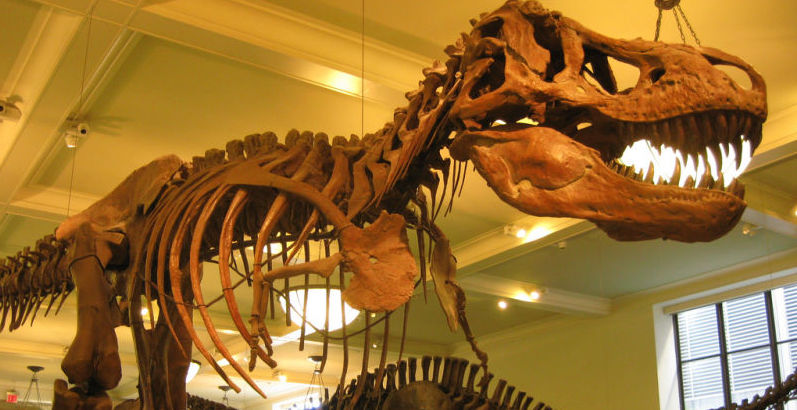Appendix:
Tyrannosaurus rex is probably the first thing to pop into our heads when we hear the word “dinosaur.” The tyrant lizard king might be the most popular dinosaur there ever was. But…its reign came at the end of an era. There were other, equally fearsome predators before it, so how did tyrannosaurs come to wear the crown? In its time, and in ours?
In today’s show, we explore the rise of tyrannosaurus in our museums and media, as well as throughout the Mesozoic Era. It may surprise you to learn that the T. rex’s earliest ancestors were hardly bigger than dogs. Here’s a look at a few members of the tyrannosaurus lineage across time:
Guanlong wucaii

Guanlong’s name means “crowned dragon,” after the crest running up the middle of its head. It’s the earliest known ancestor of the tyrannosaurus, first appearing during the Jurassic 160 million years ago. Classified as a tyrannosauroid, guanlong lacks the bulk and power of its later descendants, and is hardly recognizable as family. Note the slim neck, narrow skull, and long, three-fingered hands.


Dilong paradoxus

Dilong is proof that big things have small beginnings. Hailing from Jurassic Asia, roughly 126 million years ago, this tyrannosauroid is a significant discovery because some fossil specimens show preserved coats of proto-feathers. This tells us that feathers on dinosaurs were developing fairly early on in their history, and that members of the tyrannosaur line did have them.


Yutyrannus huali

Yutyrannus’s name means “feathered tyrant.” At roughly 25 feet long, it is the largest of the tyrannosaur family discovered so far with confirmed feathers. Dating back 124 million years to Early Cretaceous China, yutyrannus bridges the gap into tyrannosaur territory. This large predator has the beginnings of T. rex’s size and power, but still sports three-fingered hands and a ridge-like structure along its snout.


Tarbosaurus bataar

Tarbosaurus is the second-largest known tyrannosaur, and the T. rex’s Mongolian counterpart. Skin samples from tarbosaurus do not indicate the presence of feathers as seen in many of its predecessors, but rather contain only scaly pebbles. This trait seems to be fairly consistent across fossilized skin from most large tyrannosaurs, including Tyrannosaurus rex. This tells us that the larger tyrannosaurs either did not have feathers, or else likely had them in small amounts in areas of the body for which no skin samples have been found, like the head, shoulders, and back. Whether the tyrannosaur family lost their feathers as they grew larger, or perhaps lost them in the tens of millions of years since yutyrannus, remains a mystery.


Gorgosaurus libratus

Gorgosaurus is T. rex’s smaller, sleeker Canadian cousin. It had a lighter build, a longer snout, and rounder eye sockets than its more famous relative. Predating T. rex by about 10 million years, it is the most well-represented tyrannosaur in the fossil record. Fossil evidence tells us that, strangely, gorgosaurus shared its territory with another tyrannosaur: the similarly sized but thicker Daspletosaurus torosus.

Fossilized stomach contents tell us that these two predators fed on the same prey. Both animals appear to have occupied space together at the top of the food chain, perhaps like today’s lions and tigers. How they fit into the same ecosystem and whether they filled different niches is a topic of great interest.


Tyrannosaurus rex

And then there is the last and greatest: the tyrant lizard king. Tyrannosaurus rex‘s reign was tragically cut short by an asteroid strike in the Yucatan Peninsula 65 million years ago. The impact wiped out 50% of life on Earth, including all of dinosaur kind.


Popular Media
Here’s a fun look at how Tyrannosaurus rex has been represented in film since its 1918 big screen debut. Notice how in early cinema, T. rex is sort of a vicious, non-stop killing machine, slaughtering anything it encounters. But after the Paleontological Revolution in the 1970’s, when we came to better understand dinosaurs as animals and ancestors of the birds, there’s a marked difference in T. rex’s onscreen behavior. Shedding its frequent portrayal as a murderous monster, it is often billed as a hero or protagonist.
The Ghost of Slumber Mountain (1918)
Sir Arthur Conan Doyle’s The Lost World (1925)
King Kong (1933)
Fantasia (1940)
Godzilla (1954)
Dinosaurus! (1960)
The Land Before Time (1988)
https://www.youtube.com/watch?v=TU3Z9O2rdgI
Jurassic Park (1993)
We’re Back! A Dinosaur Story (1993)
Night At The Museum (2006)
https://www.youtube.com/watch?v=uaYhqImAe40
The Good Dinosaur (2015)
Jurassic World (2015) (Spoiler Warning!)
Sources:
Huge Croc Extinction Led to Dinosaur Domination by Jen Viegas
Oldest T. rex relative unveiled by Rebecca Morelle
Dilong paradoxus – Australian Museum
New Dinosaur Discovered: T. Rex Cousin Had Feathers by John Roach
Where Have All the Sauropods Gone? by Brian Switek
Remember the Alamosaurus by Brian Switek
Meet the Gigantic Carnivore That Kept T. Rex Down by Stephanie Pappas
T. Rex May Have Had Lips by Mindy Weisberger
Tyrannosaurus rouge: lips may have hidden T rex’s fierce teeth by Ashifa Kassam
Tyrannosaurus rex had scaly skin and wasn’t covered in feathers, a new study says by Ben Guarino
Evolutionary History of the Grasses by Elizabeth A. Kellogg
Evolution of Seed Plants – LumenLearning
Barnum Brown: The Man Who Discovered Tyrannosaurus Rex by Brian Switek
Museum Management:
Museum theme by Michael Guy Bowman
Listen to more at: bowman.bandcamp.com
Rachel: Designer #UkuleleWitch @rachelvice
Tour Guide: Emery Coolcats
Twitter: @natmysterycast | Email: natmysterypodcast@gmail.com | Home: pome-mag.com/category/pomecast
Follow the show on iTunes or Soundcloud!
Museum of Natural Mystery is part of the POMEcast network, and thanks a million to the ladies of POME for helping this show get up and running! But above all, thank you for listening!




